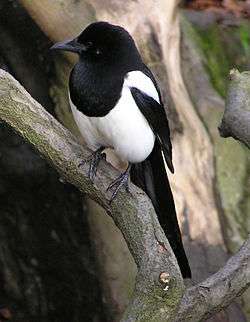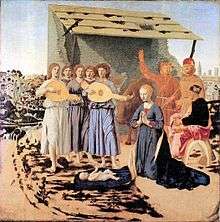One for Sorrow (nursery rhyme)
"One for Sorrow" is a traditional children's nursery rhyme about magpies. According to an old superstition, the number of magpies seen tells if one will have bad or good luck.
| "One for Sorrow" | |
|---|---|
 A magpie | |
| Nursery rhyme | |
| Published | c. 1780 |
Lyrics
There is considerable variation in the lyrics used. A common modern version follows:
One for sorrow,
Two for joy,
Three for a girl,
Four for a boy,
Five for silver,
Six for gold,
Seven for a secret,
Never to be told.
Eight for a wish,
Nine for a kiss,
Ten for a bird,
You must not miss
Eleven is worse
Twelve for a dastardly curse.[1]
Origins

The rhyme has its origins in superstitions connected with magpies, considered a bird of ill omen in some cultures, and in Britain, at least as far back as the early sixteenth century.[3] The rhyme was first recorded around 1780 in a note in John Brand's Observations on Popular Antiquities on Lincolnshire with the lyric:
One for sorrow,
Two for mirth,
Three for a funeral
And four for birth
One of the earliest versions to extend this was published, with variations, in Michael Aislabie Denham's Proverbs and Popular Saying of the Seasons (London, 1846)
One for sorrow,
Two for mirth
Three for a funeral,
Four for birth
Five for heaven
Six for hell
Seven for the devil, his own self
On occasion, jackdaws, crows and other Corvidae are associated with the rhyme, particularly in America where magpies are less common.[4]
In popular culture
A version of the rhyme became familiar to many UK children when it became the theme tune of an ITV children's TV show called Magpie, which ran from 1968 to 1980. The popularity of this version is thought to have displaced the many regional versions that had previously existed.[5]
In Neil Gaiman's epic comic book series The Sandman, one of the characters recites a variant of this rhyme in which every number is for sorrow (i.e. One for sorrow/ Two for sorrow...)
A song by the British pop group Steps is entitled "One for Sorrow".
In the Counting Crows song "A Murder of One", the lyrics contain a modified version of the rhyme. The rhyme is also the origin of the group's name.[6]
Also mentioned in book four of The Mortal Instruments, City of Fallen Angels, by Cassandra Clare. The character Simon reflects on his mother teaching him the rhyme as a child.
Eric Draven recites a modified version of the song in James O'Barr's graphic novel The Crow. Ashe Corven recites a version of the rhyme in the 1996 film The Crow: City of Angels, with crows in place of magpies.
The rhyme is in part 5 of Monday, January 12 in the mystery Through the Evil Days by Julia Spencer-Fleming when a crow caws once in a tense winter scene, leaving a character who is visualizing a grim outcome to hope for a second caw.[7]
The novels in the John, the Lord Chamberlain series of historical mysteries, taking place in Justinian's Constantinople, all have titles derived from the nursery rhyme, the first one (published in 1999) being named "One for Sorrow". The belief that the number of magpies one sees give an indication of one's future is attributed to a knight of King Arthur's Round Table visiting Constantinople in the first volume - which might be an anachronism.
British folk group The Unthanks include the song "Magpie" on their 2015 album Mount the Air, with lyrics containing portions of this rhyme.[8] The song is featured in the final scene of the first episode of the third season of Detectorists, backing a time-warp scene with multiple visual clues to the lyrics.[9]
Finnish melodic death metal band Insomnium's 2011 album One for Sorrow is named for the rhyme. The album's liner notes contain a variation of the rhyme: "One for sorrow / two for luck / three for a wedding / four for death / five for silver / six for gold / seven for a secret / not to be told / eight for heaven / nine for hell / ten for devil's own sell."
The opening two-part episode of the 2015 season of Lewis was titled "One for Sorrow", and involved a stuffed magpie.
Two versions of the rhyme play an important part in Terry Pratchett's novel Carpe Jugulum (1998), where magpies are considered the eyes of the cunning vampire Count Magpyr.
The lyrics can be found in the artwork A Flock of Words in Morecambe, amongst other poems about birds.
Lyrics from the rhyme are mentioned in Corinne Bailey Rae's song "Choux Pastry Heart",[10] from her self-titled debut album, released in 2006.
The anthology Charmed Destinies (2003) contains a story by Mercedes Lackey called "Counting Crows", in which several verses of the rhyme are given.
The song is mentioned in season four, episode nine of the Showcase series Lost Girl.[11]
It is also referenced multiple times (either in part or as a whole) in the best-selling psychological thriller novel The Girl on the Train (2015), by British author Paula Hawkins; the line "three for a girl" is used as, perhaps, an umbrella theme for the entire book, which deals with the mysterious disappearance of a woman, as narrated/gradually unfolded from the perspectives of three other female characters.
The title of a spooky young adult book by Mary Downing Hahn is "One for sorrow".
The American alternative rock band The Innocence Mission featured a song called "One for Sorrow, Two for Joy" on their 2003 release Befriended. It was written and sung by Karen Peris.
The game The Secret World features this rhyme extensively during one of the missions you must complete to good effect. (The mission is named "Something Wicked" and is in the first town you come to.) It involves a series of 7 white ravens where each says a line from the Rhyme and you have to match those lines up to a clue obtained earlier during the same mission.
Notes
- P. Tate, Flights of Fancy: Birds in Myth, Legend, and Superstition (New York: Random House, 2010), ISBN 1409035697.
- Finaldi, Gabriele (1 December 1992). "Picture Choice: Gabriele Finaldi on pictorial wisdom in Piero's relaxed Nativity". The Independent. Retrieved 2 February 2013.
- I. Opie and M. Tatem, eds, A Dictionary of Superstitions (Oxford University Press, 1989), pp. 235-6.
- J. M. Marzluff, A. Angell, P. R. Ehrlich, In the Company of Crows and Ravens (Yale University Press, 2007), p. 127.
- Terry Pratchett and Jacqueline Simpson, The Folklore of Discworld (London: Random House, 2010), ISBN 1407034243, p. 449.
- "Rolling Stone Article". 15 November 2006. Archived from the original on 15 November 2006. Retrieved 9 November 2017.
- Spencer-Fleming, Julia, Through the Evil Days (2013) St. Martin's Press N.Y. p. 165
- "The Unthanks - Mount the Air". Folk Radio UKz. 1 February 2015. Retrieved 9 November 2017.
- "Mackenzie Crook explains why this series of Detectorists will be the last". .radiotimes.com. Retrieved 9 November 2017.
- Corinne Bailey Rae – Choux Pastry Heart, retrieved 2017-02-28
- ""Lost Girl" Destiny's Child (TV Episode 2014)". IMDb.
References
- Binney, Ruth (2004). Wise Words and Country Ways: Traditional Advice and Whether It Works Today. David & Charles. p. 223. ISBN 0-7153-1846-2.
- The Crow: City of Angels. 1996.